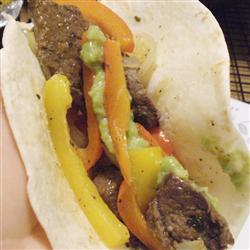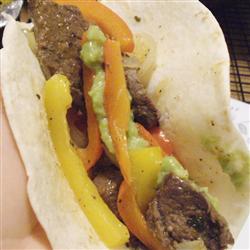Venison Fajitas
Venison Fajitas
A great Kiwi innovation that is in high demand with wild venison.
Ready in: 45 minutes
Serves: 6
Complexity: very-easy
kcal: 708
Share

Ingredients
2 tsp SIDS CRAZY SALT
½ tsp cayenne pepper
¼ tsp garlic salt
1 tsp dried oregano
1 kg venison, cut into 5 cm strips
4 tbsp rice bran oil
1 red bell pepper, cut in 5 cm strips
1 orange bell pepper, cut in 5 cm strips
1 red onion, sliced
12 fajita size flour tortillas, warmed
1 tbsp SIDS PLUM SAUCE
Directions
Combine SIDS CRAZY SALT, garlic salt, cayenne pepper and oregano to make the fajita seasoning. Sprinkle 2 teaspoons of the seasoning over the sliced venison. Mix well, cover and refrigerate for 30 minutes.
Heat 2 tablespoons of oil in a heavy frying pan. Cook bell peppers and onion until starting to soften, then remove. Pour in remaining oil and cook venison until browned. Return pepper mixture to the pan, season with remaining fajita seasoning and reheat. Served with the warmed tortillas and a squirt of SIDS PLUM SAUCE.
History: Fajita is a Tex-Mex, Texan-Mexican American or Tejano, diminutive term for little strips of meat cut from the beef skirt, the most common cut used to make fajitas. The word fajita is not known to have appeared in print until 1971, according to the Oxford English Dictionary. (The word faja is Spanish for "strip", or "belt", from the Latin fascia, "band")
Venison derives from the Latin venari (to hunt or pursue). This term entered English through the Norman in the 11th century, following the Norman invasion of England, and the establishment of Royal Forests. Venison originally described meat of any game animal killed by hunting and was applied to any animal from the families 'Cervidae' (deer), 'Leporidae' (hares) and 'Suidae' (wild pigs) and certain species of the genus Capra (goats and ibex), but in the northern hemisphere the word's usage is now almost entirely restricted to the flesh of various species of deer.

